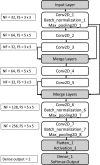A Deep Learning-Based Approach to Reduce Rescan and Recall Rates in Clinical MRI Examinations
- PMID: 30606726
- PMCID: PMC7028612
- DOI: 10.3174/ajnr.A5926
A Deep Learning-Based Approach to Reduce Rescan and Recall Rates in Clinical MRI Examinations
Abstract
Background and purpose: MR imaging rescans and recalls can create large hospital revenue loss. The purpose of this study was to develop a fast, automated method for assessing rescan need in motion-corrupted brain series.
Materials and methods: A deep learning-based approach was developed, outputting a probability for a series to be clinically useful. Comparison of this per-series probability with a threshold, which can depend on scan indication and reading radiologist, determines whether a series needs to be rescanned. The deep learning classification performance was compared with that of 4 technologists and 5 radiologists in 49 test series with low and moderate motion artifacts. These series were assumed to be scanned for 2 scan indications: screening for multiple sclerosis and stroke.
Results: The image-quality rating was found to be scan indication- and reading radiologist-dependent. Of the 49 test datasets, technologists created a mean ratio of rescans/recalls of (4.7 ± 5.1)/(9.5 ± 6.8) for MS and (8.6 ± 7.7)/(1.6 ± 1.9) for stroke. With thresholds adapted for scan indication and reading radiologist, deep learning created a rescan/recall ratio of (7.3 ± 2.2)/(3.2 ± 2.5) for MS, and (3.6 ± 1.5)/(2.8 ± 1.6) for stroke. Due to the large variability in the technologists' assessments, it was only the decrease in the recall rate for MS, for which the deep learning algorithm was trained, that was statistically significant (P = .03).
Conclusions: Fast, automated deep learning-based image-quality rating can decrease rescan and recall rates, while rendering them technologist-independent. It was estimated that decreasing rescans and recalls from the technologists' values to the values of deep learning could save hospitals $24,000/scanner/year.
© 2019 by American Journal of Neuroradiology.
Figures




References
-
- Gatidis S, Liebgott A, Schwartz M, et al. . Automated reference-free assessment of MR image quality using an active learning approach: comparison of support vector machine versus deep neural network classification. In: Proceedings of the Annual Meeting of the International Society for Magnetic Resonance in Medicine, Honolulu, Hawaii April 22–27, 2017; 3979
-
- Elsaid N, Roys S, Stone M, et al. . Phase-based motion detection for diffusion magnetic resonance imaging. In: Proceedings of the Annual Meeting of the International Society for Magnetic Resonance in Medicine, Honolulu, Hawaii April 22–27, 2017; 1288
MeSH terms
LinkOut - more resources
Full Text Sources
Medical
